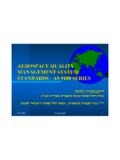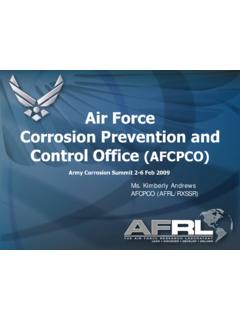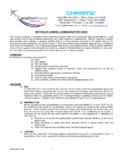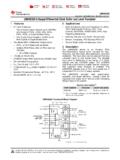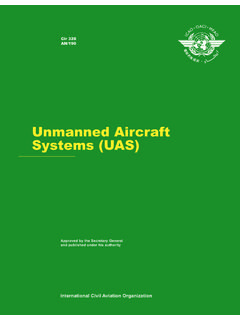Transcription of BY ORDER OF THE AIR FORCE INSTRUCTION 48-101 …
1 BY ORDER OF THE SECRETARY OF THE AIR FORCE AIR FORCE INSTRUCTION 48-101 8 DECEMBER 2014 aerospace medicine aerospace medicine enterprise COMPLIANCE WITH THIS PUBLICATION IS MANDATORY ACCESSIBILITY: Publications and forms are available on the e-Publishing website at for downloading or ordering. RELEASABILITY: There are no releasability restrictions on this publication. OPR: AF/SG3P Supersedes: AFI48-101, 19 October 2011 Certified by: AF/SG3/5 (Maj Gen Dorothy A. Hogg) Pages: 37 This INSTRUCTION implements AFPD 48-1, aerospace medicine enterprise . It provides guidance and establishes procedures for conducting the multidisciplinary aspects of the aerospace medicine enterprise (AME). It describes the key aerospace medicine programs in support of the operational aerospace mission and links them to the desired operational effects: Promote and Sustain a Healthy and Fit FORCE , Prevent Illness and Injury, Restore Health, and Sustain Human Performance.
2 This publication serves as a program management outline for the AME and the seven subordinate programs. It provides a strategic overview of the objectives, desired effects, metrics and reporting requirements for the programs which constitute the AME. Tactical management of the subordinate programs is referenced in the appropriate publications. This INSTRUCTION addresses the requirement for development of Team aerospace . This INSTRUCTION interfaces with Air FORCE 10-, 11-, 36-, 40-, 41-, 48-, 60-, 61-, 62-, 63, and 90 series publications. This publication applies to the regular Air FORCE and the Air Reserve Components. The authorities to waive wing/unit level requirements in this publication are identified with a Tier ( T-0, T-1, T-2, T-3 ) number following the compliance statement.
3 See AFI 33-360, Publications and Forms Management, for a description of the authorities associated with the Tier numbers. Requests for waivers must be submitted through the chain of command to the appropriate Tier waiver approval authority, or, alternately, to the Publication OPR for non-tiered compliance items. Any organizational level may supplement this INSTRUCTION . Refer recommended changes and questions about this publication to the Office of Primary Responsibility (OPR) using AF Forms 847, Recommendation for Change of Publication; route AF Form 847 from the field through the appropriate chain of command. Ensure that all records created as a result of processes prescribed in this publication are maintained in accordance with 2 AFI 48-101 8 DECEMBER 2014 AFMAN 33-363, Management of Records, and disposed of in accordance with Air FORCE Records Information Management System (AFRIMS) Records Disposition Schedule (RDS).
4 SUMMARY OF CHANGES This publication has been substantially revised and requires complete review. Chapter 1 PROGRAM OVERVIEW 5 Overview.. 5 AME Unit-Level Management.. 5 AME Scope.. 5 Specific Organizational Responsibilities.. 6 AME Organization and Management at Unit Level.. 13 aerospace medicine Program Leadership Forums.. 13 Chapter 2 FLIGHT AND OPERATIONAL medicine PROGRAM 17 Objectives.. 17 Key Team aerospace Players: .. 17 Desired Effects.. 17 Indicators.. 17 Leadership Forums.. 17 Reporting.. 18 Flight And Operational medicine Program Management.. 18 Chapter 3 OCCUPATIONAL AND ENVIRONMENTAL HEALTH (OEH) PROGRAM 19 Objectives.. 19 Key Team aerospace Players: .. 19 Desired Effects.. 19 Indicators.. 19 Leadership Forums.. 19 Reporting.. 20 OEH program management.. 20 Chapter 4 FORCE HEALTH PROTECTION AND MEDICAL READINESS PROGRAM 21 Objectives.
5 21 Key Team aerospace Players: .. 21 AFI 48-101 8 DECEMBER 2014 3 Desired Effects.. 21 Indicators.. 21 Leadership Forums.. 21 Reporting.. 22 FORCE Health Protection and Medical Readiness Program Management.. 22 Chapter 5 COMMUNITY HEALTH PROGRAM 23 Objectives.. 23 Key Team aerospace Players: .. 23 Desired Effects.. 23 Indicators.. 23 Leadership Forums.. 24 Reporting.. 24 Community Health Program management.. 24 Chapter 6 HUMAN PERFORMANCE SUSTAINMENT PROGRAM 25 Definitions of Human Performance Terms.. 25 Objectives.. 25 Key Team aerospace Players: .. 26 Desired Effects.. 26 Indicators.. 26 Leadership Forums.. 26 Reporting.. 26 Human Performance Program Management.. 27 Chapter 7 EMERGENCY RESPONSE/DISASTER MANAGEMENT PROGRAM 28 Objectives.. 28 Key Team aerospace Players.
6 28 Desired Effects.. 28 Indicators.. 28 Leadership Forums.. 28 Reporting.. 29 Emergency Response & Disaster Management Program management.. 29 Attachment 1 GLOSSARY OF REFERENCES AND SUPPORTING INFORMATION 30 Attachment 2 EXAMPLE TEMPLATE: AMC MEETING AGENDA 35 4 AFI 48-101 8 DECEMBER 2014 AFI 48-101 8 DECEMBER 2014 5 Chapter 1 PROGRAM OVERVIEW Overview. This INSTRUCTION provides guidance, responsibilities, and procedures for execution of the AME. The AME provides direct support to Air FORCE operations by promoting and sustaining FORCE health, preventing injury and illness, restoring health, and sustaining human performance. These key mission areas are accomplished at the unit level through effective management of seven major aerospace medicine programs. These are: Flight and Operational medicine Program.
7 Occupational and Environmental Health Program. FORCE Health Protection and Medical Readiness Program. Community Health Program. Human Performance Sustainment Program. Emergency Response/Disaster Management Program. Health Promotion. AME Unit-Level Management. Management of the aerospace medicine programs to achieve objectives and desired effects will follow established principles of program management: Establish clear objectives and goals. Define tasks and responsibilities necessary to achieve objectives. Specify clear and reasonable timelines. Ensure accountability. Measure effectiveness of reaching the objectives and desired effects. Redirect local plans, guidance, and practices as needed to better achieve desired effects. AME Scope. The AME is comprised of personnel (Team aerospace (TA)) and activities that include, but are not limited to: Aeromedical Evacuation (AE), aerospace & Operational Physiology (AOP), En Route Patient Staging, Bioenvironmental Engineering (BE), Flight and Operational medicine (FOM), Occupational medicine (OM), Optometry, Public Health (PH), Personnel Reliability Program (PRP), and Health Promotion as well as education, research and development activities related to these programs.
8 TA personnel work collaboratively for the success of the seven aerospace medicine programs. Medical treatment facilities (MTF) AMEs are represented to the Air FORCE Medical Service (AFMS) corporate structure for the purposes of planning and programming by the aerospace Operations (AO) panel. 6 AFI 48-101 8 DECEMBER 2014 The AME is implemented at locations wherever there is an AF mission. Locations include Regular Air FORCE (RegAF), Air National Guard (ANG), and Air FORCE Reserve (AFR) installations, Geographically Separated Units (GSU), sites with a Limited Scope Medical Treatment Facility (LSMTF), sites with a medical aid station (MAS), sites with a Medical Squadron, sites with no assigned medical personnel, and deployed locations. Sites with a MTF will implement the appropriate scope of the AME with assigned personnel as the base operational mission demands.
9 Defining the scope of the AME and missions covered will be the responsibility of the base Chief of aerospace medicine (SGP), Squadron and Medical Group (MDG) commanders in consultation with the base line command and Major Command (MAJCOM)/SGP. GSUs, sites with a Medical Squadron, LSMTF, MAS, or no assigned medical personnel will implement the AME with the assistance of a supporting MTF designated by the unit s owning MAJCOM/SG. The overall responsibility for the execution of the AME at supported sites will reside with the supporting MTF Commander (MTF/CC). If the nearest MTF is from another MAJCOM, the supported site will arrange through Memorandum of Understanding (MOU) or Support Agreement (SA) with that MTF after consultation with the supporting and supported MAJCOM/SGPs for the appropriate support.
10 Deployed sites will implement all aerospace medicine programs tailored to support the operational mission. As these sites mature, phasing in of more robust AME is indicated as directed by the Combatant Command (COCOM) or Air FORCE Forces (AFFOR)/Surgeon General (SG) or SGP. The timeline for phasing in will be developed by the local SGP after coordination with the appropriate COCOM, AFFOR or MAJCOM/SG or SGP. ANG or AFRC medical units will implement the AME either utilizing organic capabilities or they will ensure the quality of the AME through an actively enforced host-tenant support agreement (HTSA). The overall responsibility for ensuring the execution of the AME will reside with the ANG or AFRC medical unit, even though AME services may be provided through HTSA or contract. AD units will be responsible for services and program support agreed to in a HTSA.











